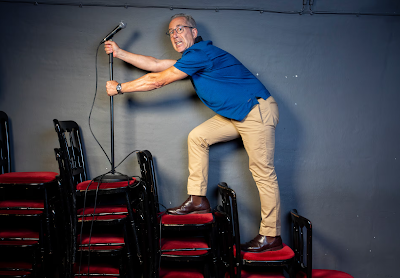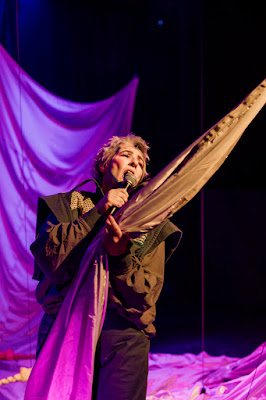After his sold-out 2019 UK tour, Ben Elton returns to the stage with Authentic Stupidity, tackling the rise of Artificial Intelligence — and arguing that it’s "Authentic Stupidity" we should really fear. A pioneer of modern stand-up since the 1980s, Elton continues to deliver his signature high-energy, thought-provoking comedy.
Ben Elton’s return to the stand-up stage with Authentic Stupidity is both a nostalgic reminder of his comedic roots and a glimpse into the disorientation of a man once known for being ahead of his time. A legend of British comedy, Elton has built a reputation over the past four decades for being politically sharp, culturally aware, and fearlessly outspoken. But in this new show, it's clear that while his energy remains undimmed, the cultural context around him has changed.
The show opens with Elton identifying his central theme: that the real danger facing humanity isn’t artificial intelligence, but what he calls “authentic stupidity”—our long-standing ability to make foolish decisions, regardless of technological progress. It's a classic Elton premise: wordplay mixed with political commentary, sharp but still accessible. He pokes fun at how people now rely on gadgets to think, navigate, and even interact, while lamenting the loss of everyday skills like reading maps or fixing things yourself.
Elton’s delivery is as relentless as ever. He paces the stage furiously, arms flailing, voice rising and falling like a conductor guiding an orchestra of chaos. There’s a breathlessness to his performance, with barely a pause between punchlines. At times, this makes it hard to absorb what he's saying—there’s simply too much to take in. His stamina is impressive, particularly for someone officially past retirement age, but the pace can leave the audience behind.
A large part of the show is given over to topics Elton has clearly spent a lot of time thinking about. Assisted dying, for example, is handled with both gravity and humour, as he passionately defends the right to choose one's end. But then there are more rambling segments, like a lengthy dissection of James Bond films, especially Daniel Craig’s efforts to bring a gritty realism to the franchise. This bit, while amusing, stretches on far too long, and resurfaces again in the second half, taking up valuable space that could have been better used exploring more current themes.
Elton’s approach to modern identity politics is where the show becomes more complex. He tries hard to embrace the cultural shifts—gender fluidity, the fall of the straight white male’s unchallenged status, and the rise of intersectionality. He acknowledges that the younger generation now hold the moral high ground, cleverly joking that it’s the only kind of real estate they can afford. But it’s clear that, while supportive, Elton doesn’t always understand the full depth of the issues. He becomes frustrated by what he sees as overly complicated language or rules and often defaults to poking fun at his own confusion.
This self-deprecation is both disarming and central to the show. Much of the material is rooted in Elton’s personal experiences of getting older. He jokes about his body letting him down, the strange new etiquette of modern dining, and the overly territorial behaviour of neighbours when it comes to recycling bins. These bits are funny, familiar, and delivered with warmth. However, they also underscore a growing theme throughout the show: that Elton, once a pioneering voice of radical thought, is now struggling to keep up.
The show includes a few moments tailored to the New Zealand audience, but many of the references remain deeply rooted in British culture. Jokes about UK law reforms in the 1980s or throwbacks to personalities like Ronnie Corbett may fly over the heads of younger fans. This limits the show’s reach, making it feel more like a personal catch-up with a familiar figure than a fully inclusive performance.
Elton’s real talent lies in his ability to find absurdity in everyday life. His best moments come when he turns the spotlight on mundane frustrations and draws out their ridiculousness. But Authentic Stupidity often moves too quickly to let these insights land. Just when a topic starts to get interesting, he swerves off into the next. The show touches on many important issues—digital echo chambers, the risks of over-inclusivity, ageing, environmental awareness—but rarely dives deep enough to offer anything more than fleeting food for thought.
There’s a sense, too, that Elton is holding back. For a comedian who made his name by challenging authority and questioning the status quo, this show feels cautious in places. Perhaps it’s a reflection of his long break from the stage or an awareness that the ground beneath him has shifted. He clearly admires the courage and principles of younger generations, but he’s not entirely comfortable navigating their terrain.
All in all, Authentic Stupidity is an enjoyable, energetic performance from a veteran comic who still knows how to command a stage. It’s a show filled with quick wit, heartfelt moments, and a few thoughtful jabs at modern life. But it also reveals the growing gap between Elton’s formative years and the world he now inhabits. He’s no longer the radical voice charging ahead of the crowd—instead, he’s a well-meaning observer, running hard to keep up.
There are laughs to be had, a few ideas to ponder on the drive home, and a certain comfort in seeing a familiar face doing what he does best. But this is not a groundbreaking return. It's a reminder that even the most progressive voices must evolve—and sometimes, evolution is a slow and stumbling process.
Ben Elton's Authentic Stupidity tours New Zealand until May 2nd 2025. Dates as follows:
- Wed 30 Apr - Napier, Napier Municipal Theatre
- Thu 01 May 25 - Dunedin, Dunedin Town Hall
- Fri 02 May 25 - Christchurch, Christchurch Town Hall
Tickets can be purchased here


















.png)

